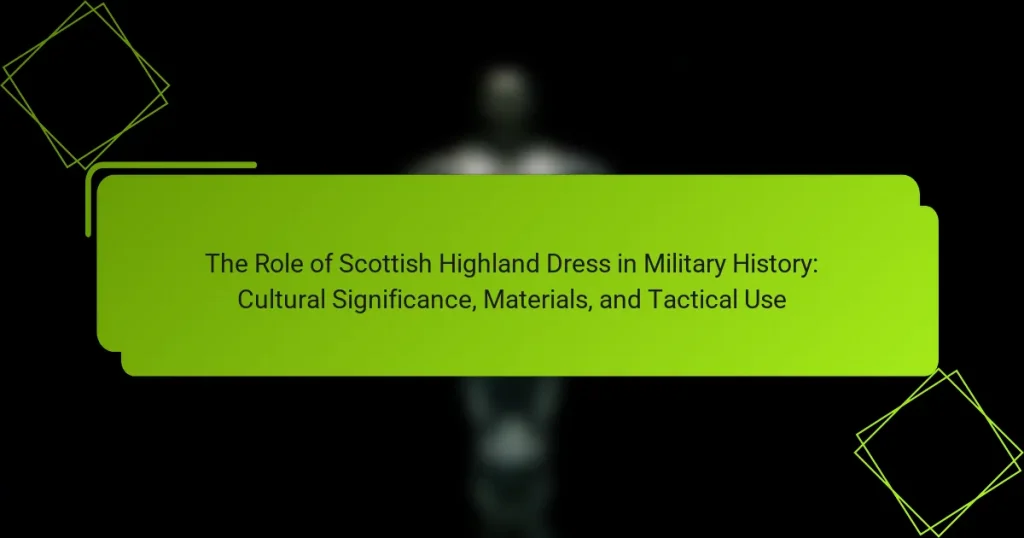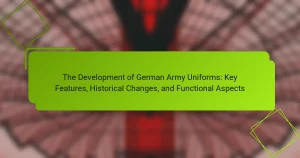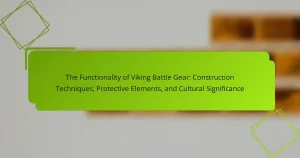Scottish Highland Dress is a traditional attire from the Scottish Highlands, prominently featuring the kilt, sporran, and distinctive tartan patterns. This dress has historical roots dating back to the 16th century, originally serving practical purposes in outdoor activities and military contexts. The kilt, made primarily of wool, is designed for mobility and camouflage, while the sporran functions as a pouch for essentials. The use of tartan patterns signifies clan identity and has evolved into a symbol of Scottish nationalism, particularly following the Jacobite uprisings. Today, Highland Dress is worn during cultural events, reflecting its significance in Scottish heritage and military tradition.
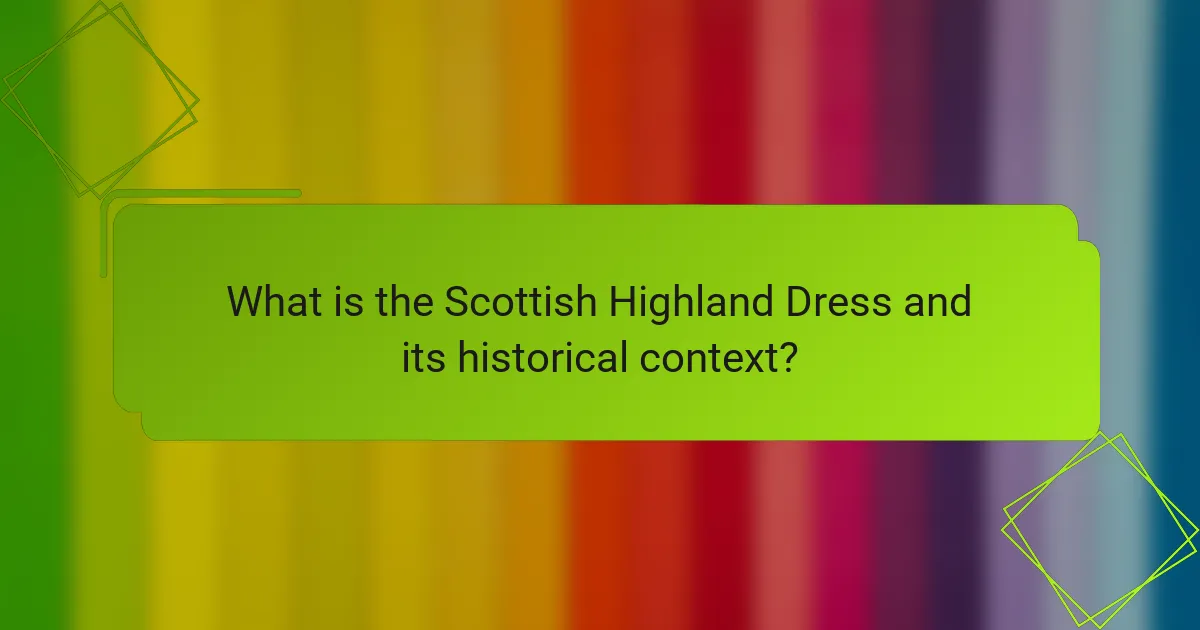
What is the Scottish Highland Dress and its historical context?
The Scottish Highland Dress is a traditional attire originating from the Scottish Highlands. It is characterized by distinctive elements such as the kilt, sporran, and tartan patterns. The kilt is typically made of wool and is pleated at the back, allowing for ease of movement. Historically, Highland Dress was worn by Scottish clans and symbolized clan identity.
The dress evolved over centuries, with roots tracing back to the 16th century. Initially, it served practical purposes for outdoor activities and warfare. The use of tartan patterns became a way to signify allegiance to specific clans. After the Jacobite uprisings in the 18th century, the Highland Dress was banned but later revived as a symbol of Scottish nationalism.
Today, it is worn during cultural events and celebrations, reflecting its historical significance and connection to Scottish heritage. The Highland Dress remains an important aspect of Scottish identity and military tradition.
How did the Scottish Highland Dress evolve over time?
The Scottish Highland Dress evolved significantly from the medieval period to modern times. Initially, it consisted of the belted plaid, a large piece of cloth wrapped around the body. This garment was practical for the rugged Highland terrain and climate. By the 17th century, the kilt emerged as a distinct item, made from tartan fabric. Tartan patterns were often associated with specific clans, enhancing identity and unity.
In the 18th century, following the Jacobite uprisings, the dress became a symbol of Scottish nationalism. The British government initially banned Highland dress in 1746, which led to underground wear and eventual revival. By the 19th century, Highland Dress was popularized through romanticized depictions in art and literature.
Military use also influenced its evolution. Highland regiments adopted the kilt for its practicality in battle. The modern Highland Dress includes accessories like the sporran and ghillie brogues, reflecting both tradition and military heritage. Today, it represents Scottish culture globally, maintaining historical significance while adapting to contemporary fashion.
What are the key historical events that influenced the development of Highland Dress?
The key historical events that influenced the development of Highland Dress include the Jacobite uprisings and the subsequent Dress Act of 1746. The Jacobite uprisings in the early 18th century emphasized Scottish identity and pride. This led to the popularization of tartan patterns among Highland clans. Following the defeat at the Battle of Culloden in 1746, the British government enacted the Dress Act. This act prohibited the wearing of Highland dress, aiming to suppress Scottish culture. Despite this, Highland dress remained a symbol of resistance and cultural identity. The repeal of the Dress Act in 1782 allowed for a revival of Highland attire. This revival was further fueled by romanticized views of Scottish culture in the 19th century. Events like the Great Highland Games also contributed to the celebration of Highland dress as a cultural emblem.
How did the Scottish clans contribute to the distinctiveness of Highland Dress?
Scottish clans significantly influenced the distinctiveness of Highland Dress through unique tartan patterns. Each clan developed specific tartans that represented their identity and heritage. These patterns were often woven into kilts, sashes, and other garments. The use of clan tartans became a symbol of loyalty and belonging. Historical records indicate that tartans were recognized as early as the 16th century. Clans used these distinctive patterns to differentiate themselves in battle and during gatherings. This practice solidified the cultural significance of Highland Dress. As a result, Highland Dress became a visual representation of clan identity and pride.
What are the cultural significances of the Scottish Highland Dress?
The Scottish Highland Dress symbolizes cultural identity and heritage. It reflects the history and traditions of the Scottish Highlands. The kilt, a key component, represents clan affiliation through tartan patterns. Each tartan is unique to a specific clan, fostering a sense of belonging. The dress is also worn during significant cultural events, reinforcing Scottish pride. Additionally, Highland Dress has military significance, historically worn by Scottish regiments. This attire showcases bravery and loyalty, contributing to Scotland’s military legacy. The Highland Dress continues to be a vital expression of Scottish culture today.
How does Highland Dress reflect Scottish identity and heritage?
Highland Dress reflects Scottish identity and heritage through its distinctive patterns, colors, and historical significance. The tartan patterns represent specific Scottish clans, linking individuals to their ancestral roots. Each clan’s tartan carries unique meanings and stories, symbolizing unity and pride. The kilt, a key component of Highland Dress, is recognized globally as a symbol of Scottish culture. Historically, Highland Dress was worn by Scottish soldiers, showcasing bravery and loyalty. The attire has evolved but remains a powerful representation of Scotland’s rich traditions. Events like Highland Games celebrate this heritage, reinforcing cultural identity.
What role does Highland Dress play in contemporary Scottish culture?
Highland Dress plays a significant role in contemporary Scottish culture as a symbol of national identity. It represents Scotland’s rich heritage and traditions. Highland Dress is often worn during cultural events, weddings, and festivals. Kilts, sporrans, and tartans are key components of this attire. The use of specific tartans can denote clan affiliation and pride. Highland Dress also serves to promote Scottish culture globally. It is featured in parades and performances, showcasing Scotland’s unique customs. This attire fosters a sense of community among Scots and those of Scottish descent.
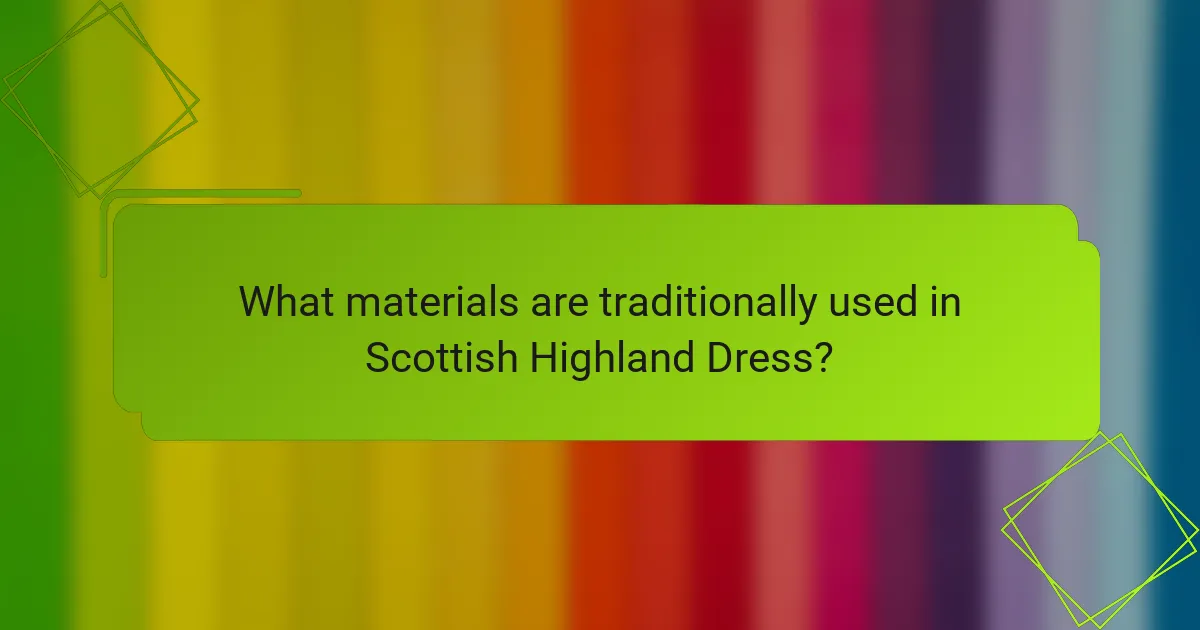
What materials are traditionally used in Scottish Highland Dress?
Scottish Highland Dress traditionally uses wool, leather, and cotton. Wool is primarily used for kilts, which are often made from tartan patterns. Leather is commonly utilized for accessories like sporrans and shoes. Cotton may be used in shirts and other garments. These materials are durable and suited for the rugged Scottish landscape. Historical records indicate that wool was favored for its warmth and resilience. The use of tartan dates back centuries, symbolizing clan identity and heritage.
What types of fabrics are commonly associated with Highland Dress?
Highland Dress is commonly associated with wool, tweed, and tartan fabrics. Wool is favored for its warmth and durability, making it suitable for the Scottish climate. Tweed, a robust fabric, is often used in jackets and caps. Tartan patterns, which represent different Scottish clans, are integral to Highland Dress. These fabrics have historical roots, with wool being used since ancient times in Scotland. The use of tartan can be traced back to the 16th century, symbolizing clan identity and heritage.
How do these materials impact the durability and functionality of the dress?
The materials used in Scottish Highland dress significantly impact its durability and functionality. Wool, commonly used, is known for its strength and resistance to wear. This natural fiber provides insulation, keeping soldiers warm in cold conditions. Additionally, wool can wick moisture away, maintaining comfort during physical exertion.
Cotton may also be incorporated for breathability, enhancing overall comfort. However, it lacks the durability of wool. Leather elements, often present in accessories, contribute to the dress’s robustness. They provide protection and support during combat situations.
The combination of these materials ensures that the dress withstands harsh conditions while allowing freedom of movement. Historical records indicate that Highland soldiers valued these functional aspects during military engagements. The choice of materials directly influenced their effectiveness on the battlefield.
What are the traditional methods of sourcing and producing these materials?
Traditional methods of sourcing and producing materials for Scottish Highland dress include hand-weaving and natural dyeing. Wool was commonly harvested from local sheep breeds, such as the Scottish Blackface. Artisans would spin the wool into yarn using traditional spinning wheels.
The weaving process often took place on handlooms, which allowed for intricate patterns and textures. Natural dyes sourced from local plants, such as woad and madder, were used to color the fabrics.
Historically, these methods were passed down through generations, preserving cultural heritage. The production of tartan patterns was often specific to clans, reflecting their identity.
These traditional techniques are still celebrated today in the making of authentic Highland dress.
What are the variations in materials based on regional differences?
Variations in materials for Scottish Highland dress are influenced by regional differences in Scotland. Different areas have distinct access to local resources. For example, the Highlands often feature wool from native sheep breeds. This wool is known for its durability and warmth. In contrast, the Lowlands may utilize lighter fabrics like cotton or linen. These materials were historically more accessible due to agricultural practices. Additionally, specific regions developed unique tartan patterns based on local clan heritage. The colors and designs reflect the natural landscape and available dyes. Historical records indicate that these regional distinctions were significant in military contexts. Soldiers’ uniforms often indicated their origin and allegiance.
How do climate and geography influence material choices in Highland Dress?
Climate and geography significantly influence material choices in Highland Dress. The cool, wet climate of the Scottish Highlands necessitates the use of warm and water-resistant materials. Traditionally, wool is favored for its insulation and moisture-wicking properties. This fabric helps keep wearers warm in cold weather while allowing breathability. The rugged terrain also impacts fabric durability; sturdy materials are essential for withstanding harsh conditions. Additionally, the availability of local resources influences material selection. Historically, tartan patterns were created from locally sourced wool, reflecting regional identity. Thus, climate and geography shape both the practicality and cultural significance of Highland Dress.
What unique attributes do specific materials bring to Highland Dress?
Highland Dress incorporates unique attributes from specific materials that enhance its cultural significance and functionality. Wool, commonly used in kilts and jackets, provides warmth and durability. It is also water-resistant, making it suitable for the Scottish climate. Leather, utilized in sporrans and footwear, offers strength and protection. It also contributes to the traditional aesthetic of Highland Dress. Tartan patterns, made from dyed wool, symbolize clan identity and heritage. The distinct colors and designs represent specific clans, enhancing the wearer’s connection to their ancestry. Silk is often used in decorative elements, adding a touch of elegance and refinement. These materials collectively contribute to the historical and cultural fabric of Highland Dress, reinforcing its role in Scottish military history.
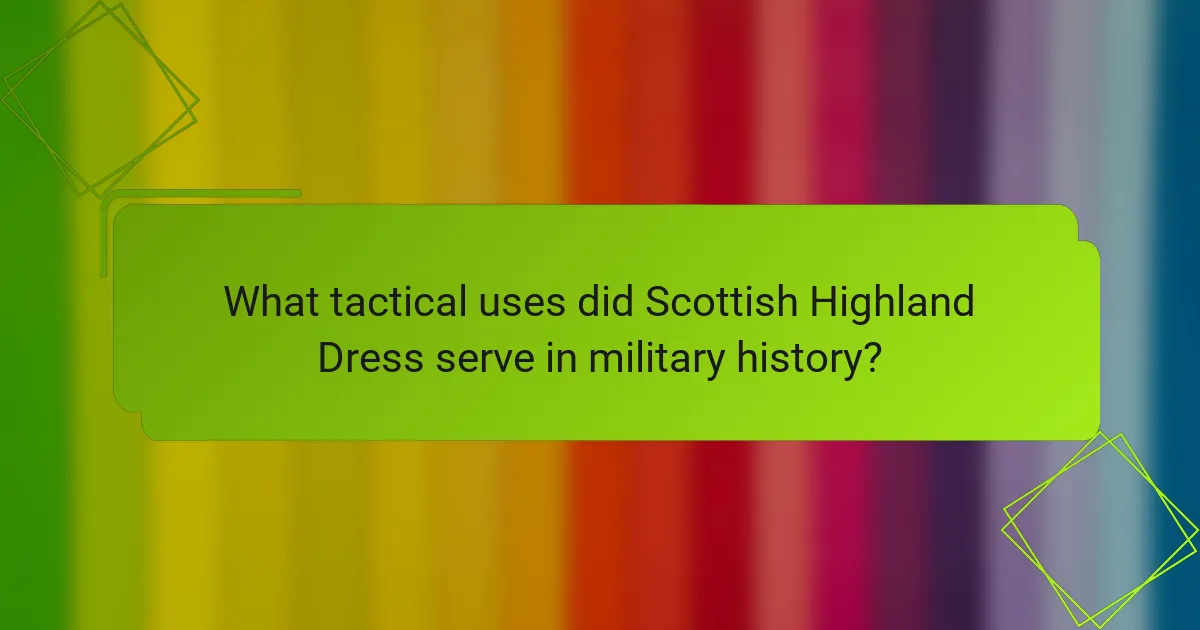
What tactical uses did Scottish Highland Dress serve in military history?
Scottish Highland Dress served tactical purposes in military history by providing camouflage and mobility. The kilt, made of tartan, allowed soldiers to blend into the Scottish landscape. This was particularly effective in the Highlands, where terrain varied from heather to rocky outcrops.
Highland Dress also facilitated ease of movement. The kilt’s design allowed for greater leg mobility during combat. Soldiers could run and maneuver more effectively than in traditional military trousers.
Additionally, the dress included a sporran, which served as a functional pouch for carrying essentials. This practicality was essential during long campaigns.
The use of Highland Dress also fostered unit cohesion and morale. Soldiers identified with their clan tartans, creating a sense of belonging.
Historical records show that Highland regiments, such as the Black Watch, utilized this dress effectively in various battles. Their distinctive appearance became a symbol of bravery and loyalty in the British Army.
How did Highland Dress contribute to military effectiveness in battle?
Highland Dress contributed to military effectiveness in battle through its distinctive design and functionality. The kilt allowed for ease of movement, enhancing agility on the battlefield. Its tartan patterns also served as a form of camouflage in the Scottish terrain. Additionally, the use of wool provided warmth and durability in harsh weather conditions. The traditional dress fostered unit cohesion and morale among soldiers, creating a sense of identity and pride. Historical examples include the effectiveness of Highland regiments during the Napoleonic Wars, where their attire was both practical and psychologically advantageous. The combination of these factors made Highland Dress a significant asset in military engagements.
What specific design features of Highland Dress aided soldiers in combat?
Highland Dress featured several design elements that aided soldiers in combat. The kilt allowed for freedom of movement, essential for agility during battle. Made of durable wool, the fabric provided warmth and protection against harsh weather. The tartan pattern helped with camouflage in the Scottish landscape, blending soldiers into their surroundings. The sporran, worn at the front, secured vital items while allowing for mobility. The long socks and garters kept the kilt secure during movement. Additionally, the sash provided a means to carry equipment or weapons. These features combined to enhance the soldiers’ effectiveness and survivability in combat situations.
How did the use of Highland Dress differ among various Scottish regiments?
Highland Dress varied significantly among Scottish regiments. Each regiment had distinct tartans representing their unique heritage. For example, the Black Watch wore a dark tartan, symbolizing their distinguished history. Conversely, the Argyll and Sutherland Highlanders sported a lighter tartan with a different pattern. Additionally, the use of specific accessories varied; some regiments included feather bonnets, while others opted for different headgear. The style of kilt and sporran also differed, reflecting the individual traditions of each regiment. Historical records indicate that these variations fostered a sense of identity and pride among the soldiers. The differences in Highland Dress were not merely aesthetic but also served as a means of unit recognition on the battlefield.
What are the historical examples of Highland Dress in military engagements?
Highland Dress has been prominently featured in various military engagements throughout history. One notable example is the Jacobite risings of the 18th century. Highland soldiers wore kilts and tartans, symbolizing their clan allegiance. The Battle of Culloden in 1746 showcased Highland Dress as troops fought in traditional attire.
Another example is the use of Highland regiments in the British Army. The 42nd Highlanders, known as the Black Watch, wore distinctive tartan uniforms during the Napoleonic Wars. Their attire became iconic, representing Scottish heritage in military contexts.
Additionally, Highland Dress was present during World War I. The Scottish regiments donned kilts and sporrans while fighting in the trenches. This attire served both as a morale booster and a symbol of national pride.
Highland Dress has thus played a significant role in military history, representing cultural identity and unity among Scottish soldiers.
How did Highland Dress impact the perception of Scottish soldiers in warfare?
Highland Dress significantly influenced the perception of Scottish soldiers in warfare. The distinctive attire, characterized by kilts and tartans, projected a sense of bravery and cultural pride. This unique dress set Scottish soldiers apart from other military units. It contributed to the romanticized image of the Highlander as a fierce warrior. Historical battles, such as the Jacobite uprisings, showcased Highland Dress prominently. The attire became a symbol of resistance and national identity. Additionally, it fostered a sense of camaraderie among soldiers. The visual impact of Highland Dress often intimidated opponents on the battlefield. Overall, it enhanced the reputation of Scottish soldiers as formidable fighters.
What lessons can be learned from the tactical use of Highland Dress in military history?
The tactical use of Highland Dress in military history demonstrates the importance of adaptability in combat. Highland Dress provided soldiers with mobility and camouflage in rugged terrain. The use of tartan patterns helped troops blend into the Scottish landscape. Historical examples include the Jacobite uprisings, where Highlanders utilized their dress for tactical advantage. The unique attributes of Highland Dress also fostered unit cohesion and morale among troops. The effectiveness of this dress in guerrilla warfare highlighted the significance of local knowledge in military strategy. Overall, Highland Dress exemplifies how cultural elements can enhance tactical effectiveness in military operations.
What practical tips should one consider when choosing or wearing Highland Dress today?
When choosing or wearing Highland Dress today, consider the fit and comfort of the attire. Proper sizing ensures ease of movement, which is crucial for both formal and casual occasions. Next, select appropriate tartan patterns that reflect personal or family heritage. Each tartan has historical significance, enhancing cultural connection. Pay attention to the quality of materials used, as traditional Highland Dress is often made from wool, providing warmth and durability. Accessories such as sporrans and kilt pins should complement the outfit while adhering to traditional styles. Finally, remember to wear the attire with confidence, as Highland Dress is a symbol of pride and identity in Scottish culture.
The Scottish Highland Dress is a traditional attire with deep historical roots in Scottish military history, characterized by elements such as the kilt, sporran, and distinctive tartan patterns. This article explores the evolution of Highland Dress, highlighting its cultural significance, the materials used, and its tactical applications in military contexts. Key historical events, including the Jacobite uprisings and the Dress Act of 1746, shaped its development and reinforced its role as a symbol of Scottish identity. Additionally, the article examines how specific materials impact the functionality and durability of the dress, as well as the design features that aided soldiers in combat. Insights into contemporary practices and considerations when wearing Highland Dress are also provided.
